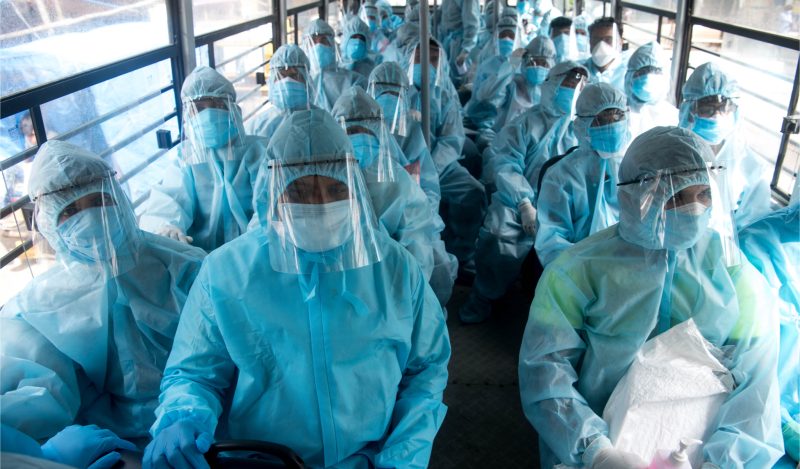A few decades ago, Polymerase Chain Reaction (PCR) robots, DNA sequencers, and high-speed computers fostered and accompanied quite a scientific revolution in virology. Acknowledging this radical change, some illustrious scholars alerted their scientific community on a hazardous drift away from investigating the viral ecology, pathogenesis, and disease potential, along with viral identification by testing. “In summary”, wrote Calisher and al. (2001),
remarkable advances in molecular genetics have allowed rapid and precise identifications of viruses and of their genomes; however, such characterizations thus far can provide only limited information about the phenotype and disease potential of a virus.
Their position paper was noticed and its lead author, Professor Charles H. Calisher, was interviewed by Science (Enserink 2001):
Thanks to techniques such as PCR and sequencing, diagnostic labs everywhere can perform high -sensitivity tests for a battery of viruses in a matter of hours. […] Although all that is terrific, says Calisher, a string of DNA letters in a data bank tells little or nothing about how a virus multiplies, which animals carry it, how it makes people sick, or whether antibodies to other viruses might protect against it. Just studying sequences, Calisher says, is “like trying to say whether somebody has bad breath by looking at his fingerprint.”
The fundamental issue raised by Calisher et al. (2001) was that, without complementing genomic testing with phenotypic and epidemiologic information, “it will be much harder to understand and fight the next dangerous virus that comes along” (Enserink 2001). In other words, ‘miasma’ and ‘germ’ theories should go along together, complementing each other.
Calisher et al. (2001)’ claim has proved to be quite prophetic. That issue shakes the very foundation on which the dominant approach to COVID-19 pandemic management and policy lays upon. Once the virus was identified, testing positive was conflated with being sick. And mass testing has been advocated and deployed in quite an impossible effort to trace the viral diffusion in real time. On 9 March 2022, the WHO renewed once again its call for mass testing:
WHO is concerned that several countries are drastically reducing testing. This inhibits our ability to see where the virus is, how it’s spreading and how it’s evolving. Testing remains a vital tool in our fight against the pandemic, as part of a comprehensive strategy.
This approach is based on the fatal conceit that we can gather the full picture of the ongoing phenomenon in real time, and even forecast it through time and space (Biondi 2021). In a similar vein, vaccination has been advocated and deployed in view to eradicate the viral presence and stop the viral spread, through discriminatory measures against the unvaccinated in many cases.
For both mass testing and mass vaccination, the actual medical conditions and epidemiological contexts were neglected. Consequently, a critical question remained unasked: When you test positive, are you actually sick?
Drawing upon Calisher et al. (2001), testing positive does not necessarily imply being or becoming sick. In a nutshell, we have been counting the so-called ‘cases’ by testing disparate people who carry COVID-19 viral fragments in their upper respiratory tract. But this circumstance does not tell us much about their underlying medical conditions, neither the reasons for their hospitalisation or death (Biondi 2021).
First of all, testing techniques are never perfect. With low viral incidence (for example 1%), a test with 99% sensitivity and 99% specificity is likely to generate only a 50% positive predictive value (with 10% incidence, 90.91% positive predictive value). Moreover, PCR robots need to be calibrated, with higher calibration values being increasingly uncorrelated with viral active presence in the host.
Only when a properly calibrated test is a true positive, it may indicate that the virus is actively present. But this presence does not imply that its host is or will become sick. In many COVID-19 cases, no illness is developed (surely thanks to general immune defence), or hidden illness showing no symptoms (so-called asymptomatic cases), or just a minor disease that may remain quite unnoticed (unless a test alarms its host beyond reason).
In the remaining cases, more serious illness may be developing, requiring medical attention and showing medical evidence of disease. Since late spring 2020, statistical and medical evidence have been available showing which people are vulnerable and then exposed at serious risk. As a matter of fact, development of serious illness and severe outcome has been limited to a tiny share of population, the vast majority of ‘cases’ being non-existent, mild or asymptomatic.
Therefore, both testing and vaccination may be directed to these vulnerable people, as long as adverse events from vaccination are comprehensively gathered and carefully investigated, in view to enable doctors to advice on vaccination benefits and risks at the individual level. This alternative approach is based upon informed consent and respect of fundamental rights (Biondi 2022a).
For instance, according to the Florida Department of Health’s New COVID-19 Testing Guidance (Florida Health Depth 2022):
In conclusion, imagine if we test for cold all people being admitted to hospitals. We may certainly obtain seasonal waves of persons hospitalised with cold, but this latter circumstance would not add any relevant information about their personal medical condition for public health purposes.
While contact tracing and isolation may be important for some infectious diseases, it is futile and counterproductive for common infections such as influenza and Covid-19. A case is only a case if a person is sick. Mass testing asymptomatic and non-vulnerable individuals is harmful to public health, useless and expensive (Biondi 2022b).
An alternative public health approach may seek for focused protection of vulnerable people, including through voluntary vaccination campaigns, while trusting pre-existing immune defence and emergent natural immunity for non-vulnerable ones.
References
Calisher, C. H. et al. (2001), Identification of Arboviruses and Certain Rodent-Borne Viruses: Reevaluation of the Paradigm, Emerging Infectious Diseases, Vol. 7, No. 4, July–August, pp. 756-8
Enserink, M. (2001), Old Guard Urges Virologists To Go Back to Basics, Science, vol. 293, no. 5527, 6 July 2001, pp. 24-5
Florida Health Department (2022), Office of the State Surgeon General Joseph A. Ladapo, Testing Guidance for COVID-19, January 6, 2022.
World Health Organisation – WHO (2022), WHO Director-General’s opening remarks at the media briefing on COVID-19 and Ukraine – 9 March 2022, Tedros Adhanom Ghebreyesus.
Further Readings
- Biondi, Yuri (2021). “Accounting for Pandemic: Better Numbers for Management and Policy,” Accounting, Economics, and Law: A Convivium, vol. 11, no. 3, 2021, pp. 277-291.
- Biondi, Yuri (2022a). “A reasonable map for vaccination decision-making”, February 13, 2022. Linkedin Blog
- Biondi, Yuri (2022b). “How pandemic management maximises spending”, February 7, 2022, Linkedin Blog.
Join the conversation:


Published under a Creative Commons Attribution 4.0 International License
For reprints, please set the canonical link back to the original Brownstone Institute Article and Author.









